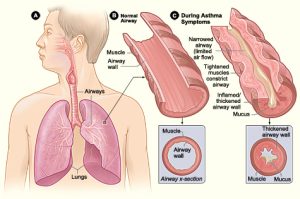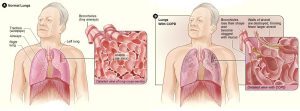5.3 Respiratory System Pathologies
A number of pathologies can affect the respiratory system, and the most common pathologies are discussed below. Many of these pathologies can be treated with lifestyle changes and medications that will be discussed later in this chapter.
Common Pathologies
Asthma: This common condition affects the lungs of both adults and children. Approximately 10.8% of Canadians (3.8 million people) are living with asthma (Government of Canada, 2018). In addition, asthma is the most frequent cause of hospitalization in children.
Asthma is a chronic disease characterized by inflammation and edema of the airway, as well as bronchospasms, which can inhibit air from entering the lungs. In addition, excessive mucus secretion can occur, which further contributes to airway occlusion.
Bronchospasms occur periodically and lead to an asthma attack. An attack may be triggered by environmental factors such as dust, pollen, pet hair or dander, changes in the weather, mould, tobacco smoke, and respiratory infections, or by exercise and stress. Fig. 5.8 provides an image of a normal airway and an airway during an asthma attack.

Symptoms of an asthma attack involve coughing, shortness of breath, wheezing, and tightness of the chest. Symptoms of a severe asthma attack that requires immediate medical attention would include difficulty breathing that results in blue (cyanotic) lips or face, confusion, drowsiness, tachycardia, sweating, and severe anxiety. The severity of the condition, frequency of attacks, and identified triggers influence the type of medication that an individual may require and will be discussed later in this chapter. Longer-term treatments are used for those with more severe asthma. Short-term, fast-acting drugs that are used to treat an asthma attack are typically administered via an inhaler. For young children or individuals who have difficulty using an inhaler, asthma medications can be administered using a nebulizer.
In many cases, the underlying cause of the condition is unknown. However, recent research has demonstrated that certain viruses, such as human rhinovirus C (HRVC) and the bacteria Mycoplasma pneumoniae and Chlamydia pneumoniae that are contracted in infancy or early childhood, may contribute to the development of many cases of asthma.
The following video provides a detailed description of asthma and how it affects those that have it.
(TED-Ed, 2017)
Key Concept
The burning of a tobacco cigarette creates multiple chemical compounds that are released through mainstream smoke, which is inhaled by the smoker, and through sidestream smoke, which is the smoke given off by the burning cigarette (Betts et al., 2013). Second-hand smoke, which is a combination of sidestream smoke and the mainstream smoke that is exhaled by the smoker, has been demonstrated by numerous scientific studies to cause disease (Betts et al., 2013). At least 40 chemicals in sidestream smoke that negatively impact human health have been identified and can lead to the development of cancer or other conditions, such as immune system dysfunction, liver toxicity, cardiac arrhythmias, pulmonary edema, and neurological dysfunction. Furthermore, second-hand smoke has been found to harbour at least 250 compounds that are known to be toxic, carcinogenic, or both. Some major classes of carcinogens in second-hand smoke are polyaromatic hydrocarbons (PAHs), N-nitrosamines, aromatic amines, formaldehyde, and acetaldehyde (Betts et al., 2013).
Tobacco and second-hand smoke are considered to be carcinogenic (Betts et al., 2013). Exposure to second-hand smoke can cause lung cancer in individuals who are not tobacco users themselves. It is estimated that the risk of developing lung cancer is increased by up to 30% in nonsmokers who live with an individual who smokes in the house, as compared to nonsmokers who are not regularly exposed to second-hand smoke (Betts et al., 2013). Children are especially affected by second-hand smoke. Children who live with an individual who smokes inside the home have more lower respiratory infections, which are associated with hospitalizations, and a higher risk of sudden infant death syndrome (SIDS) (Betts et al., 2013). Second-hand smoke in the home has also been linked to a greater number of ear infections in children, as well as worsening symptoms of asthma (Betts et al., 2013).
Note: In the next section of this chapter, medications will be discussed that can be used to help those who want to stop smoking.
Allergies: These occur when the body’s immune system reacts to a foreign substance such as pollen, bee venom, pet dander, or food. For most people, a foreign substance does not cause a reaction, but for those who are allergic to the substance, it does.
The immune system produces proteins known as antibodies. When someone has allergies, the immune system makes antibodies that identify a particular substance as harmful, even though it may not be. When someone comes into contact with the allergen, the immune system’s reaction can inflame the skin, sinuses, airways, or digestive system.
The severity of allergies varies from person to person and can range from minor irritation to a potentially life-threatening emergency. Although most allergies can’t be cured, treatments can help relieve allergy symptoms.
Some reactions to allergens are listed below:
Hay fever, also called allergic rhinitis, can cause
-
- Sneezing
- Itching of the nose, eyes, or roof of the mouth
- Runny, stuffy nose
- Conjunctivitis
A food allergy can cause
-
- Tingling in the mouth
- Swelling of the lips, tongue, face, or throat
- Hives
- Anaphylaxis
An insect sting allergy can cause
-
- Edema at the sting site
- Itching or hives all over the body
- Cough, chest tightness, wheezing, or shortness of breath
- Anaphylaxis
A medication allergy can cause
-
- Hives
- Itchy skin
- Rash
- Facial swelling
- Wheezing
- Anaphylaxis
Atopic dermatitis, an allergic skin condition also called eczema, can cause skin to
-
- Itch
- Redden
- Flake or peel
Anaphylaxis: Some types of allergies, including allergies to foods and insect stings, can trigger a severe reaction known as anaphylaxis. It is a life-threatening medical emergency that can cause a person to go into shock.
Signs and symptoms of anaphylaxis include the following:
-
- Loss of consciousness
- Drop in blood pressure
- Severe shortness of breath
- Skin rash
- Lightheadedness
- Weak, rapid pulse
- Nausea and vomiting
Bronchitis: This is an inflammation of the lining of the bronchial tubes, which carry air to and from the lungs. Those with bronchitis often cough up thickened mucus, which may be discoloured. Bronchitis may be either acute or chronic.
Acute bronchitis is very common and often develops from a cold or other respiratory infection. Also called a chest cold, this type of bronchitis usually improves within a week to 10 days without lasting effects, though the cough may linger for weeks.
Chronic bronchitis, a more serious condition, is characterized by constant irritation or inflammation of the lining of the bronchial tubes, often caused by smoking. It is one of the conditions included in COPD (Mayo Clinic Staff, 2017).
The symptoms of both acute bronchitis and chronic bronchitis may include the following:
-
- Cough
- Production of mucus (sputum), which can be clear, white, yellowish-grey, or green; rarely, it may be streaked with blood
- Fatigue
- Shortness of breath
- Slight fever and chills
- Chest discomfort
Cold: The common cold is a viral infection of the upper respiratory tract. Many types of viruses can cause a cold. Children younger than six years of age are at greatest risk of colds, but healthy adults can also expect to have two or three colds annually. The symptoms of a common cold usually appear one to three days after exposure to a cold-causing virus. Most people recover from a common cold in a week or 10 days, though symptoms might last longer in people who smoke.
Signs and symptoms a cold, which can vary from person to person, may include the following:
-
- Runny or stuffy nose
- Sore throat
- Cough
- Congestion
- Slight body aches or a mild headache
- Sneezing
- Low-grade fever
- Generally feeling unwell
Chronic obstructive pulmonary disease (COPD): This chronic inflammatory lung disease causes obstructed airflow out of the lungs. Symptoms include difficulty breathing, cough, mucus (sputum) production, and wheezing. It is often caused by long-term exposure to irritating gases or dust, and most often occurs because of smoking. People with COPD are at increased risk of developing heart disease, lung cancer, and a variety of other conditions.
Emphysema and chronic bronchitis are the two types of COPD. Emphysema is a condition in which the alveoli at the end of the smallest air passages (bronchioles) of the lungs are destroyed and become hyperinflated. Chronic bronchitis is inflammation of the lining of the bronchial tubes and is characterized by daily coughing and mucus (sputum) production. See Fig. 5.9 for an illustration of normal lungs compared to lungs affected by COPD.

COPD is treatable but not curable. Symptoms often do not appear until significant lung damage has occurred, and they usually worsen over time, particularly if smoke exposure continues.
Other signs and symptoms of COPD may include the following:
-
- Shortness of breath, especially during physical activity
- Wheezing
- Chest tightness
- Chronic cough that may produce mucus (sputum), which may be clear, white, yellow, or greenish
- Cyanosis
- Frequent respiratory infections
- Lack of energy
- Unintended weight loss (in later stages)
Unlike some diseases, COPD has a clear cause and a clear path of prevention. The majority of cases are directly related to cigarette smoking, and the best way to prevent COPD is to never smoke or to stop smoking immediately (Mayo Clinic. 2020).
The following video describes the main causes, signs and symptoms, and management of COPD.
(Animated COPD Patient, 2014)
Attribution
Unless otherwise indicated, material on this page has been adapted from the following resource:
Ernstmeyer, K., & Christman, E. (Eds.). (2020). Nursing pharmacology. Chippewa Valley Technical College. https://wtcs.pressbooks.pub/pharmacology/, licensed under CC BY 4.0
References
Animated COPD Patient. (2014, August 15). Understanding COPD. [Video]. YouTube. https://www.youtube.com/watch?v=T1G9Rl65M-Q
Betts, J. G., Young, K. A., Wise, J. A., Johnson, E., Poe, B., Kruse, D. H., Korol, O., Johnson, J. E., Womble, M., & DeSaix, P. (2013). Anatomy and physiology. OpenStax. https://openstax.org/details/books/anatomy-and-physiology, licensed under CC BY 4.0
Government of Canada. (2018). Data blog: Asthma in Canada. https://health-infobase.canada.ca/datalab/asthma-blog.html#:~:text=The%20age%2Dstandardized%20prevalence%20of,ranked%20health%20regions%20in%20Canada
Mayo Clinic Staff. (2022). Allergies. https://www.mayoclinic.org/diseases-conditions/allergies/symptoms-causes/syc-20351497
Mayo Clinic Staff. (2020). COPD. https://www.mayoclinic.org/diseases-conditions/copd/symptoms-causes/syc-20353679
Mayo Clinic Staff. (2017). Bronchitis. https://www.mayoclinic.org/diseases-conditions/bronchitis/symptoms-causes/syc-20355566
TED-Ed. (2017, May 11). How does asthma work? – Christopher E. Gaw [Video]. YouTube. https://www.youtube.com/watch?v=PzfLDi-sL3w
Image Credits (images are listed in order of appearance)
Asthma attack-illustration NIH by National Institute of Health: National Heart, Lung, Blood Institute, Public domain
Copd 2010Side by National Institute of Health: National Heart, Lung, Blood Institute, Public domain
when the muscles that surround the bronchi tighten
increased heart rate
cancer causing or producing
an inflammation of the conjunctiva, causing watery, red, and swollen eyes; also known as "pink eye"
swelling in the body, often in the lower limbs

